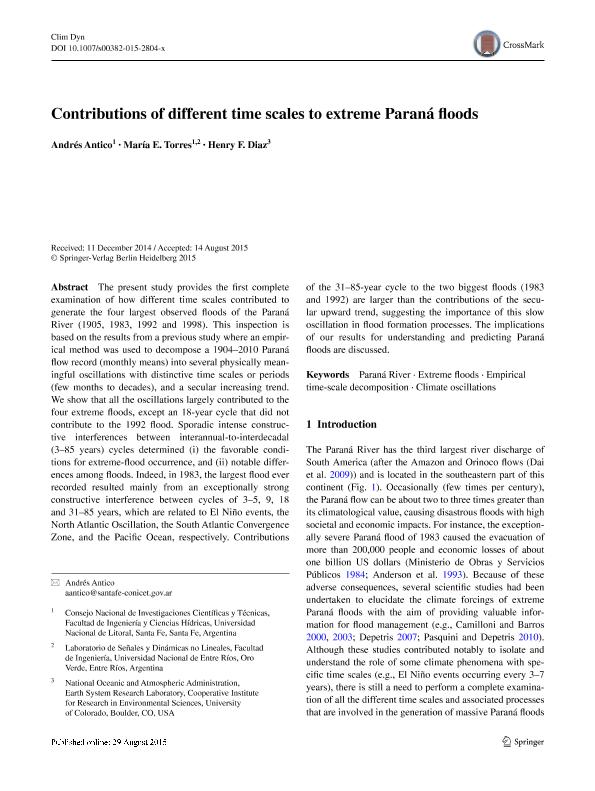Mostrar el registro sencillo del ítem
dc.contributor.author
Antico, Andres

dc.contributor.author
Torres, Maria Eugenia

dc.contributor.author
Diaz, Henry F.
dc.date.available
2018-05-22T21:07:35Z
dc.date.issued
2015-06
dc.identifier.citation
Antico, Andres; Torres, Maria Eugenia; Diaz, Henry F.; Contributions of different time scales to extreme Paraná floods; Springer; Climate Dynamics; 46; 11-12; 6-2015; 3785-3792
dc.identifier.issn
0930-7575
dc.identifier.uri
http://hdl.handle.net/11336/45961
dc.description.abstract
The present study provides the first complete examination of how different time scales contributed to generate the four largest observed floods of the Paraná River (1905, 1983, 1992 and 1998). This inspection is based on the results from a previous study where an empirical method was used to decompose a 1904-2010 Paraná flow record (monthly means) into several physically meaningful oscillations with distinctive time scales or periods (few months to decades), and a secular increasing trend. We show that all the oscillations largely contributed to the four extreme floods, except an 18-year cycle that did not contribute to the 1992 flood. Sporadic intense constructive interferences between interannual-to-interdecadal (3-85 years) cycles determined (i) the favorable conditions for extreme-flood occurrence, and (ii) notable differences among floods. Indeed, in 1983, the largest flood ever recorded resulted mainly from an exceptionally strong constructive interference between cycles of 3-5, 9, 18 and 31-85 years, which are related to El Niño events, the North Atlantic Oscillation, the South Atlantic Convergence Zone, and the Pacific Ocean, respectively. Contributions of the 31-85-year cycle to the two biggest floods (1983 and 1992) are larger than the contributions of the secular upward trend, suggesting the importance of this slow oscillation in flood formation processes. The implications of our results for understanding and predicting Paraná floods are discussed.
dc.format
application/pdf
dc.language.iso
eng
dc.publisher
Springer

dc.rights
info:eu-repo/semantics/openAccess
dc.rights.uri
https://creativecommons.org/licenses/by-nc-sa/2.5/ar/
dc.subject
Parana River
dc.subject
Extreme Floods
dc.subject
Empirical Time-Scale Decomposition
dc.subject
Climate Oscillations
dc.subject.classification
Meteorología y Ciencias Atmosféricas

dc.subject.classification
Ciencias de la Tierra y relacionadas con el Medio Ambiente

dc.subject.classification
CIENCIAS NATURALES Y EXACTAS

dc.title
Contributions of different time scales to extreme Paraná floods
dc.type
info:eu-repo/semantics/article
dc.type
info:ar-repo/semantics/artículo
dc.type
info:eu-repo/semantics/publishedVersion
dc.date.updated
2018-05-04T21:42:43Z
dc.journal.volume
46
dc.journal.number
11-12
dc.journal.pagination
3785-3792
dc.journal.pais
Alemania

dc.journal.ciudad
Berlin
dc.description.fil
Fil: Antico, Andres. Universidad Nacional del Litoral. Facultad de Ingeniería y Ciencias Hídricas; Argentina. Consejo Nacional de Investigaciones Científicas y Técnicas. Centro Científico Tecnológico Conicet - Santa Fe; Argentina
dc.description.fil
Fil: Torres, Maria Eugenia. Universidad Nacional de Entre Ríos. Facultad de Ingeniería; Argentina. Consejo Nacional de Investigaciones Científicas y Técnicas. Centro Científico Tecnológico Conicet - Santa Fe; Argentina
dc.description.fil
Fil: Diaz, Henry F.. State University of Colorado Boulder; Estados Unidos
dc.journal.title
Climate Dynamics

dc.relation.alternativeid
info:eu-repo/semantics/altIdentifier/doi/http://dx.doi.org/10.1007/s00382-015-2804-x
dc.relation.alternativeid
info:eu-repo/semantics/altIdentifier/url/https://link.springer.com/article/10.1007%2Fs00382-015-2804-x
Archivos asociados
